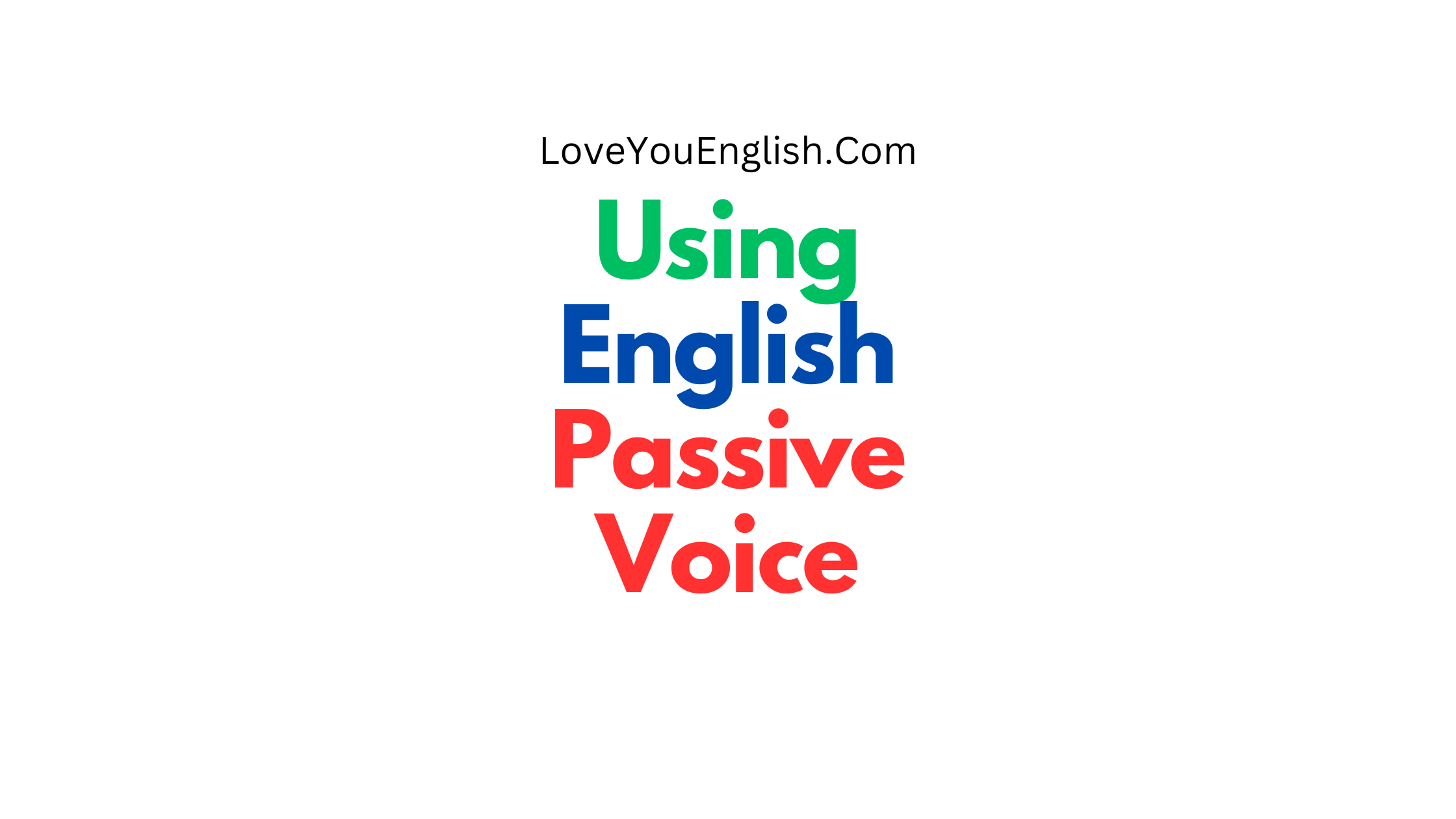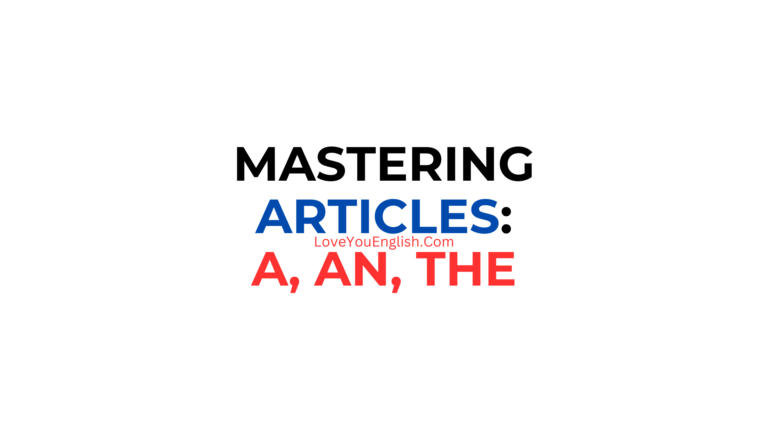How to Use the English Passive Voice: A Simple Guide
Hello everyone,
Have you ever been confused by sentences like “The cake was baked by my grandmother” or “The report will be submitted tomorrow”?
If so, you’re not alone. These sentences use what’s called the “passive voice” in English grammar.
While it might sound complicated, it’s actually a useful tool that can make your writing clearer and more effective—when used correctly.
In this lesson, we’ll dive into the world of passive voice.
I’ll explain what it is, how it works when to use it, and when to avoid it.
What Is the Passive Voice?
To understand the passive voice, let’s first look at its opposite: the active voice.
In active voice sentences, the subject (the person or thing doing the action) comes before the verb (the action word).
For example:
- My grandmother baked the cake.
- The team will submit the report tomorrow.
In these sentences, “My grandmother” and “The team” are the subjects. They’re doing the actions “baked” and “will submit.”
Now, let’s flip these sentences into the passive voice:
- The cake was baked by my grandmother.
- The report will be submitted tomorrow.
In passive voice sentences, the object (the thing receiving the action) becomes the subject.
So, “The cake” and “The report” are now at the start of the sentences.
The original subjects, “My grandmother” and “The team,” either move to the end or disappear entirely.
This is the key difference:
- Active voice: Subject → Verb → Object
- Passive voice: Object → Verb → (Optional: by Subject)
In the passive voice, the focus shifts from who’s doing the action to what’s receiving the action.
This shift can be very useful in certain situations.
How to Form Passive Voice Sentences
Creating passive voice sentences isn’t as hard as it might seem.
Just follow these steps:
- Take the object from the active sentence and make it the subject of the passive sentence.
- Use a form of “to be” (is, was, will be, etc.) + the past participle of the main verb.
- (Optional) Add “by” and the original subject at the end.
Let’s see this in action with our cake example:
Active: My grandmother baked the cake.
- Object: the cake
- Main verb: baked
Passive:
- Make “the cake” the subject: The cake
- Use “to be” + past participle: The cake was baked
- (Optional) Add “by” and original subject: The cake was baked by my grandmother.
Here are more examples in different tenses:
Present Simple
-
- Active: The chef prepares sushi.
- Passive: Sushi is prepared (by the chef).
Past Simple
-
- Active: Dogs chased the cat.
- Passive: The cat was chased (by dogs).
Present Perfect
-
- Active: They have fixed the car.
- Passive: The car has been fixed (by them).
Future Simple
-
- Active: The company will launch a new product.
- Passive: A new product will be launched (by the company).
-
- Active: You must complete the task.
- Passive: The task must be completed (by you).
Notice that in each passive sentence, we use a form of “to be” plus the past participle.
The original subject is optional, which is why it’s in parentheses.
When to Use the Passive Voice
Now that you know how to form passive voice sentences, the big question is: when should you use them?
The passive voice isn’t just a grammar trick; it’s a tool that serves specific purposes.
Here are the main times when passive voice shines:
When the Doer Is Unknown or Unimportant Sometimes, you don’t know who did something, or it doesn’t matter who did it. In these cases, the passive voice is perfect.
For example:
-
- “My bike was stolen last night.” (You don’t know who stole it.)
- “Coffee is grown in many countries.” (The specific farmers aren’t important.)
To Emphasize the Receiver of the Action In some situations, what happened is more important than who did it. The passive voice puts the spotlight on the receiver.
For instance:
In Scientific or Technical Writing In science, the focus is often on the process or results, not the researchers.
Passive voice helps maintain this objective tone:
-
- “The samples were heated to 100°C.”
- “Data is collected every hour.”
To Be More Polite or Diplomatic The passive voice can soften criticism or bad news by removing direct blame:
To Create a Sense of Mystery or Intrigue In stories, especially mysteries, the passive voice can build suspense by hiding the actor:
-
- “The door was slowly opened.”
- “A scream was heard in the night.”
When the Subject Is Too Long If the subject is a long phrase, putting it at the end can make the sentence clearer:
-
- Active: “The combined efforts of firefighters, police, and community volunteers saved the town.”
- Passive: “The town was saved by the combined efforts of firefighters, police, and community volunteers.”
To Maintain Topic Consistency If you’re discussing a particular topic, using passive voice can help keep that topic as the subject:
Common Mistakes with Passive Voice
While the passive voice is useful, it’s easy to misuse.
Here are some common mistakes to watch out for:
Overusing It The biggest mistake is using passive voice too much.
In English, active voice is more common and often clearer. Save passive voice for when it truly serves a purpose.
Forgetting to Change the Verb Remember, in passive voice, you need “to be” + past participle.
A common error is forgetting to change the verb:
-
- Wrong: “The cake was bake by my grandmother.”
- Right: “The cake was baked by my grandmother.”
Using It with Intransitive Verbs Some verbs, like “sleep” or “arrive,” don’t take direct objects. You can’t use these in passive voice:
-
- Wrong: “A good night was slept by me.”
- Right: “I slept well.” (Only active voice works here.)
Creating Ambiguity Sometimes, passive voice can make it unclear who did what:
-
- Confusing: “The contract was signed.” (By whom?)
- Clearer: “The manager signed the contract.”
Making Text Too Wordy Passive sentences often use more words than active ones:
-
- Wordy: “The ball was kicked by Tom into the goal.”
- Concise: “Tom kicked the ball into the goal.”
Losing Impact In some cases, passive voice can make your writing less powerful:
When to Avoid Passive Voice
While passive voice has its uses, there are times when you should steer clear of it:
In Most General Writing For everyday writing—emails, stories, blog posts—stick mostly to active voice.
It’s more direct and engaging.
When Clarity Is Key If it’s crucial to know who did what, use active voice:
-
- Unclear: “The project was mismanaged.”
- Clear: “The previous manager mishandled the project.”
In Action-Packed Writing In stories or news reports about exciting events, active voice conveys energy better:
-
- Passive: “The goal was scored as the whistle was blown.”
- Active: “He scored the goal just as the referee blew the whistle!”
When Assigning Responsibility If you want to credit someone or hold them accountable, be direct with active voice:
-
- Passive: “The charity event was organized.”
- Active: “Maria organized the charity event.”
In Instructions or Directions When giving steps to follow, active voice is clearer:
-
- Confusing: “The flour should be added, then the bowl should be stirred.”
- Clear: “Add the flour, then stir the bowl.”
When Your Teacher or Boss Says So Some instructors or style guides discourage passive voice. Always follow their rules!:)
Passive Voice in Different Types of Writing
The passive voice fits better in some types of writing than others. Let’s look at how it’s used across different genres:
Academic Writing
News Reporting
Fiction Writing
-
- Common Use: Sparingly used.
- Why: Mainly for style, mystery, or shifting focus.
- Example: “The old mansion was haunted by restless spirits.”
Business Writing
Legal Writing
Technical Manuals
Personal Writing (Emails, Blogs)
-
- Common Use: Not very common.
- Why: Active voice is more personal and engaging.
- Example: Use “I loved your gift” over “Your gift was loved by me.”
Passive Voice Across English Dialects
Interestingly, the use of passive voice can vary across different forms of English:
American English
-
- Tendency: Generally prefers active voice.
- Style Guides: Many discourage overusing passive.
- Example Preference: “The committee approved the budget” over “The budget was approved by the committee.”
British English
Academic English (International)
Business English
-
- Tendency: Varies by industry and culture.
- U.S. vs. U.K.: U.S. often more direct, U.K. can be more reserved.
- Example: A U.K. report might say “Inefficiencies were identified,” while a U.S. one says “We identified inefficiencies.”
Passive Voice and Tone
The choice between active and passive voice significantly affects your writing’s tone:
Formal vs. Informal
-
- Passive: Often sounds more formal.
- Active: Generally more casual.
- Compare: “You are hereby notified” (formal) vs. “I’m telling you” (informal).
Objective vs. Personal
-
- Passive: Creates distance, seems more objective.
- Active: More personal, shows involvement.
- Compare: “Mistakes were made” (objective) vs. “I made mistakes” (personal).
Soft vs. Strong
-
- Passive: Can soften criticism or bad news.
- Active: More assertive and direct.
- Compare: “Your submission was not accepted” (soft) vs. “We rejected your submission” (strong).
Mysterious vs. Clear
-
- Passive: Can add mystery or withhold info.
- Active: Directly states who did what.
- Compare: “A decision was reached” (mysterious) vs. “The board decided” (clear).
Quick Tips for Mastering Passive Voice
Identify the Verb
Spot Missing “Actors”
-
- No “by” phrase? It’s probably passive: “The meeting was postponed.”
Question Who/What
-
- Ask “By whom?” or “By what?” If it fits, it’s passive: “Dinner was served.” (By whom? The waiter.)
Use Passive Intentionally
-
- Don’t just fall into it; choose it for a reason.
Read Aloud
-
- Passive can sound wordy or unclear when spoken.
Check Field-Specific Style
-
- See how passive is used in your area (science, law, etc.).
Balance Is Key
-
- Mix passive and active for the best effect.
Real-World Passive Voice Examples
Let’s look at passive voice in action across various real-life texts:
Science Paper
“Samples were collected from 20 sites. Each sample was analyzed for pH levels. Results were compared to previous studies.”
News Article
“Three civilians were killed in the attack. The city’s power grid was severely damaged. Rescue efforts are being coordinated by international teams.”
Product Manual
“This device should not be exposed to water. If wet, power should be disconnected immediately. Repairs must be performed by authorized technicians.”
Corporate Email
“Q3 projections have been revised. A new strategy is being developed. All teams will be briefed next week.”
Novel Excerpt
“The old letter was found in the attic. Its edges were worn, as if often handled. Inside, a lock of hair was carefully preserved.”
Legal Document
“The defendant’s rights were read. Evidence was presented by the prosecution. A verdict of guilty was reached by the jury.”
Historical Text
“The Magna Carta was signed in 1215. Many of its principles were adopted by later democracies.”
Personal Blog
“I thought I was prepared, but wow, was I wrong! My skills were tested like never before. In the end, a valuable lesson was learned.”
Each of these examples uses passive voice to suit its specific needs—whether it’s maintaining objectivity, focusing on events over people, or adding a sense of mystery.
Conclusion
The passive voice is a powerful tool in English grammar.
Like any tool, it shines in some tasks and falls flat in others.
Here’s your passive voice recap:
Use It When:
The doer is unknown or unimportant
You want to emphasize the receiver
You’re writing scientifically or technically
You need to be diplomatic
You’re creating mystery
The subject is long
You’re maintaining topic focus
Avoid It When:
Writing generally
Clarity is crucial
Describing action-packed events
Assigning credit or blame
Your teacher or boss says no
Remember:
Form: Object → “to be” + Past Participle → (by Subject)
Don’t overuse it
Watch for common mistakes
Consider your field and audience
Use it to set the right tone
_________________________________________
Mastering the passive voice doesn’t mean using it all the time.
In fact, it’s quite the opposite!
The art is in knowing when this special tool is just right for the job.
In most everyday English, active voice will be your go-to.
But when you need to shift focus, soften a message, or match a certain style, the passive voice is ready in your grammar toolbox.
Practice spotting passive voice in your reading.
Try crafting some passive sentences yourself.
Soon, you’ll be switching between active and passive voices with ease, making your English more precise, professional, and powerful.
Whether you’re writing a lab report, a news story, or a personal email, you’ll know exactly when to let the passive voice take the stage.







